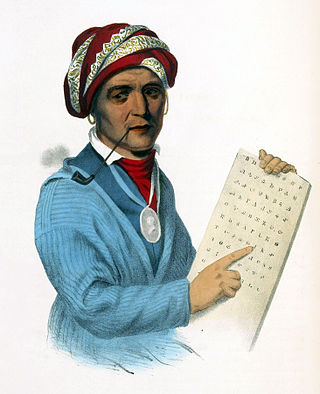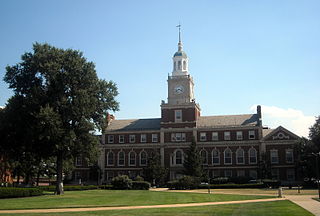Related Research Articles

Sandford C. Faulkner, better known as Sandy Faulkner, was an American planter, raconteur and fiddler who personified the mid-19th century folk song "Arkansas Traveler," for which he received writing credit. It has since gone on to become the official state historic song of Arkansas.

Sequoyah, also known as George Gist or George Guess, was a Native American polymath and neographer of the Cherokee Nation. In 1821, he completed his independent creation of the Cherokee syllabary, making reading and writing in Cherokee possible. His achievement was one of the few times in recorded history that an individual who was a member of a pre-literate group created an original, effective writing system. His creation of the syllabary allowed the Cherokee nation to be one of the first North American Indigenous groups to have a written language. Sequoyah was also an important representative for the Cherokee nation, by going to Washington, D.C. to sign two relocations and trading of land treaties.

The American Antiquarian Society (AAS), located in Worcester, Massachusetts, is both a learned society and a national research library of pre-twentieth-century American history and culture. Founded in 1812, it is the oldest historical society in the United States with a national focus. Its main building, known as Antiquarian Hall, is a U.S. National Historic Landmark in recognition of this legacy. The mission of the AAS is to collect, preserve and make available for study all printed records of what is now known as the United States of America. This includes materials from the first European settlement through the year 1876.

The University of Arkansas at Little Rock is a public research university in Little Rock, Arkansas. Established as Little Rock Junior College by the Little Rock School District in 1927, the institution became a private four-year university under the name Little Rock University in 1957. It returned to public status in 1969 when it merged with the University of Arkansas System under its present name. The former campus of Little Rock Junior College is now (2019) the campus of Philander Smith University.

The Arthur and Elizabeth Schlesinger Library on the History of Women in America is a research library at the Radcliffe Institute for Advanced Study, Harvard University. According to Nancy F. Cott, the Carl and Lily Pforzheimer Foundation Director, it is "the largest and most significant repository of documents covering women's lives and activities in the United States".

The Moorland–Spingarn Research Center (MSRC) in Washington, D.C., is located on the campus of Howard University on the first and ground floors of Founders Library. The MSRC is recognized as one of the world's largest and most comprehensive repositories for the documentation of the history and culture of people of African descent in Africa, the Americas, and other parts of the world. As one of Howard University's major research facilities, the MSRC collects, preserves, organizes and makes available for research a wide range of resources chronicling the Black experience. Thus, it maintains a tradition of service which dates to the formative years of Howard University, when materials related to Africa and African Americans were first acquired.

The UA Little Rock William H. Bowen School of Law is a public law school, part of the University of Arkansas at Little Rock. The school is both American Bar Association (ABA) accredited and a member of the Association of American Law Schools (AALS).

The Wisconsin Historical Society is simultaneously a state agency and a private membership organization whose purpose is to maintain, promote and spread knowledge relating to the history of North America, with an emphasis on the state of Wisconsin and the trans-Allegheny West. Founded in 1846 and chartered in 1853, it is the oldest historical society in the United States to receive continuous public funding. The society's headquarters are located in Madison, Wisconsin, on the campus of the University of Wisconsin–Madison.
ANPA is an acronym for:
The Sophia Smith Collection at Smith College is an internationally recognized repository of manuscripts, photographs, periodicals and other primary sources in women's history.

The National Library of Armenia is a national public library in Yerevan, Armenia. It was founded in 1832 as part of the state gymnasium-school of Yerevan. It is the official cultural repository for the entire republic.

A special library is a library that provides specialized information resources on a particular subject, serves a specialized and limited clientele, and delivers specialized services to that clientele. Special libraries include corporate libraries, government libraries, law libraries, medical libraries, museum libraries, news libraries. Special libraries also exist within academic institutions. These libraries are included as special libraries because they are often funded separately from the rest of the university and they serve a targeted group of users.

Little Rock is the capital and most populous city of the U.S. state of Arkansas. The city's population was 204,405 in 2022. The six-county Little Rock metropolitan area is the 81st-most populous in the United States with 748,031 residents according to the 2020 census.
Louis Francis Burns was a Native American historian, author, and teacher, known as a leading expert on the history, oral history and culture of the Osage Nation. Burns wrote more than a dozen books and scholarly works on the Osage people. In 2002 he was inducted into the Oklahoma Historians Hall of Fame.

The Montana State University Library (MSU Library) is the academic library of Montana State University, Montana's land-grant university, in Bozeman, Montana, United States. It is the flagship library for all of the Montana State University System's campuses. In 1978, the library was named the Roland R. Renne Library to honor the sixth president of the university. The library supports the research and information needs of Montana's students, faculty, and the Montana Extension Service.

The mission of the Butler Center for Arkansas Studies is to promote "a greater understanding and appreciation of Arkansas history, literature, art, and culture." Named after Richard C. Butler Sr., a noted Little Rock lawyer and philanthropist, the primary function of the Butler Center is as a research library and historical archive, specializing in Arkansas related materials. The offices and collections of the Butler Center are located in the Bobby L. Roberts Library of Arkansas History & Art in Little Rock.

The Amistad Research Center (ARC) is an independent archives and manuscripts repository in the United States that specializes in the history of African Americans and ethnic minorities. It is one of the first institutions of its kind in the United States to collect African American ethnic historical records and to document the modern Civil Rights Movement.
Native American newspapers are news publications in the United States published by Native American people often for Native American audiences. The first such publication was the Cherokee Phoenix, started in 1828 by the Cherokee Nation. Although Native American people have always written for state and local newspapers, including the official publications of Native American boarding schools, periodicals produced by Native people themselves were relatively few and far between until the 20th century.
The Little Rock–Pine Bluff media market, which encompasses the state capital and two of the largest metropolitan areas in the U.S. state of Arkansas, maintains a variety of broadcast, print and online media outlets serving the region. The Little Rock–Pine Bluff market includes 38 counties in the central, north-central and west-central portions of the state, serving a total population of 1,172,700 residents ages 12 and over as of 2021. As of September 2021, it is ranked as the 59th largest American television market by Nielsen Media Research and the 92nd largest American radio market by Nielsen Audio.
References
- 1 2 Center, Sequoyah National Research; 2801 S. University Ave. Fine Arts, Room 156 Little Rock; sequoyah@ualr.edu, Phone:501-916-3336 Email; information, More contact. "History of SNRC - Sequoyah National Research Center - UA Little Rock". Sequoyah National Research Center. Retrieved 2024-01-19.
{{cite web}}: CS1 maint: numeric names: authors list (link)